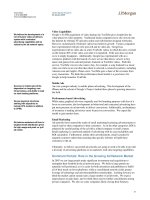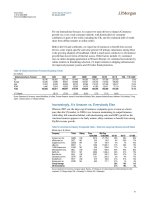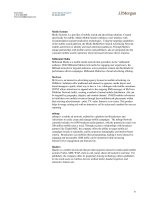Tài liệu Nothing But Net 2009 Internet Investment Guide 12 ppt
Bạn đang xem bản rút gọn của tài liệu. Xem và tải ngay bản đầy đủ của tài liệu tại đây (63.11 KB, 10 trang )
111
Global Equity Research
05 Januar
y 2009
Imran Khan
(1-212) 622-6693
Figure 69: Email Use - China Behind Korea and US
91.0%
82.1%
56.5%
0.0%
20.0%
40.0%
60.0%
80.0%
100.0%
US Korea China
Source: CNNIC (2007), Pew Internet Study (Aug '06), NDIA Survey on Computer and Internet
Use (Dec '06)
Figure 70: IM Use - Significantly Higher in China
39.0%
47.7%
81.4%
0.0%
20.0%
40.0%
60.0%
80.0%
100.0%
US Korea China
Source: CNNIC (2007), Pew Internet Study (Aug '06), NDIA Survey on Computer and Internet
Use (Dec '06)
112
Global Equity Research
05 Januar
y 2009
Imran Khan
(1-212) 622-6693
Online Advertising
We Maintain Our Positive View on 2009 and Longer-Term
Online Ad Market Growth
While there are debates over how China’s economy will shape up over the next 2-3
years, we believe strongly that Internet usage will continue to grow despite more
challenging economic conditions. Lower computer prices, declining connection fees,
higher influence of online media, and government support should continue to drive
Internet growth in China.
Further, whether China’s 2009 GDP growth rate turns out to be over 9% or a lower
5-6% (in a “hard landing” scenario), GDP growth should add further upside to a base
case of 18% online brand media growth, in our view. Indeed, with better
measurements and lower price, online ads will likely be a preferred medium in
difficult times. Also, the online ad market still only accounts for a very small portion
of China’s overall ad market (still less than 10%).
We forecast the online ad market to witness 28% Y/Y growth in 2009 to reach
Rmb14.3B (US$2.1B), and 37% Y/Y growth in 2010 to reach Rmb19.6B (US$2.9B).
Search Ad to Grow Faster than Brand Ad
We expect search advertising to see stronger growth in 2009 than brand advertising.
From a top-down perspective, search ad is still ~40% of the total online ad market in
China. This compares with 67% in the US. As such, we still see room to grow.
From a bottom-up perspective, we expect: (1) higher adoption of pay-for-
performance advertising during challenging macro environment, (2) search usage to
increase with the growing eCommerce market, and (3) use of search ads as a brand
advertising tool.
Table 54: China Online Advertising Market Forecast
2004 2005 2006 2007 2008E 2009E 2010E
Brand Advertising (RMB M) 1,700 2,329 3,377 4,559 6,428 7,585 10,013
Search Advertising (RMB M) 584 846 1,442 2,851 4,663 6,614 9,438
Other Online Format (RMB M) 70 91 109 122 135 148 163
Total Online ad market (RMB M): 2,354 3,266 4,928 7,533 11,226 14,347 19,614
Total Online ad market (US$M) 284 402 621 999 1,627 2,092 2,860
Growth Rate (Rmb, %) 99% 39% 51% 53% 49% 28% 37%
Total China ad market (Rmb M) 78,778 90,704 105,712 116,422 155,074 178,336 203,303
Growth Rate (Rmb, %) 12% 15% 17% 10% 11.0% 15.0% 14%
Ad market as % of GDP 0.49% 0.50% 0.50% 0.47% 0.49% 0.49% 0.50%
Online ad as % of Total ad market 3.0% 3.6% 4.7% 6.5% 8.0% 9.3% 11.0%
Source: iResearch, CNNIC, J.P. Morgan estimates. Note: Growth rates are in Rmb terms.
Online Advertising: Top-Down Perspective
Internet Usage Growth – Same Old Story, But Is That What Is Driving the
Online Ad Spending Growth Expected in 2009?
We expect China's Internet user base to grow around 20% Y/Y in 2009 to 24%
penetration, from its current penetration rate of 20%. As mentioned earlier, this is
driven by lower-priced computers, more affordable telecom connection fees,
government support of Internet usage, low-cost entertainment aspects, etc. As of
113
Global Equity Research
05 Januar
y 2009
Imran Khan
(1-212) 622-6693
June 2008, the number of Internet users in China was 253 million (or 20% of the
population). By the end of 2009, we expect the Internet population to reach ~320
million (or 24% of the population).
Figure 71: China Internet Users and Penetration Rate
23
27
34
46
59
68
80
87
94
103
111
123
137
162
210
253
268
295
322
347
375
0
100
200
300
400
500
600
Dec-00
Jun-01
Dec-01
Jun-02
Dec-02
Jun-03
Dec-03
Jun-04
Dec-04
Jun-05
Dec-05
Jun-06
Dec-06
Jun-07
Dec-07
Jun-08
Dec-08E
Jun-09E
Dec-09E
Jun-10E
Dec-10E
0%
5%
10%
15%
20%
25%
30%
Number of China Internet Users (Left, millions)
Penetration Rate as % of Total Population (Right)
Source: CNNIC, J.P. Morgan estimates.
We believe if the number of Internet users grows 20% Y/Y (or roughly equal to the
increase in media consumption), a minimum of ~18% Y/Y growth in online brand ad
spending should be achievable, given: (1) higher number of hours spent online per
user, (2) Internet can reach a broader audience in smaller cities in China, (3) more
measurable and lower cost compared with traditional media like TV, (4) general
inflation in advertising rates, and (5) GDP growth should also drive overall ad
spending up.
GDP Growth Likely Between 6.0-9.5%: Added to 20% Internet User Growth =
Potential 26-29% Growth
According to J.P. Morgan chief China Economist Frank Gong, Chinese officials are
forecasting that China's economic growth may slow to "8%" oya, from nearly 12%
oya in 2007, while many in the market have been pricing in a “hard landing” scenario
in which China's GDP growth could dip into 6-8% oya territory.
While the few percentage points difference in the top and bottom ranges of GDP
significantly changes the investment sentiments, from a fundamental revenue
perspective, we believe online ad industry could potentially grow roughly 26% (20%
of penetration growth + 6%GDP growth) to 29% (20% of penetration growth +
9%GDP growth).
Indeed, J.P. Morgan forecasts domestic consumption to pick up at a faster pace in
2009 vs. 2008. This should be positive for domestic ad spending.
US Advertising Spending = 2% of GDP vs. China’s 0.5%
Although ad spend as a percent of GDP in China is still below the US level, as such
we still believe advertising in China can grow at least in line with GDP. Online ads
114
Global Equity Research
05 Januar
y 2009
Imran Khan
(1-212) 622-6693
should grow even faster; therefore a projection for flat growth is quite bearish, in our
view.
Online Brand Advertising Only Accounts for 3.5% of Overall Advertising, as
per CTR Market Research
According to the latest CTR Research (leading cross-media research company in
China), online brand advertising accounts for 3.5% of overall advertising. We believe
if advertisers were to cut overall advertising, TV would be the first medium to be cut
as rates are higher and results are less measurable vs. Internet. This compares to
around 8% in the US and more than 10% in the UK.
Figure 72: China Advertising Spending Breakdown by Medium
TV
74.4%
New spaper
13.2%
Magazine
1.9%
Outdoor
3.8%
Other new media
2.3%
Radio
0.9%
Internet
3.5%
Source: CTR Market Research, Feb 2008
We believe advertisers may likely reduce the budget on some types of traditional
media, such as TV/newspapers, and turn more to Internet advertising. The CPM (cost
per thousand) based price for Internet is around Rmb15-20, vs. Rmb50-100 for TV.
Therefore, from a cost and reach basis (Internet can reach the whole nation, vs. local
TV), the Internet still appears to be at an advantage vs. TV stations.
In addition, performance for Internet advertising is more measurable. Therefore,
during times of budget tightening, advertisers will likely use the Internet as a more
measurable media.
Online Advertising: Bottom-Up Perspective
Many investors also expected concerns over trends in a few significant sectors for
online advertising: automobiles, real estate and financial services.
Automobiles Advertising
Our auto analyst, Frank Li, currently expects auto sales revenue to be roughly flat to
slightly down in China in 2009 (with units flat and average selling price down ~5%).
Driver 1: Increased Online Allocation
Currently ~10% of automobiles advertising budget is allocated online in China,
according to CTR Market Research. We believe that, with Internet population
growing, more measurable results, and lower rates vs. TV, automobile companies
will continue to increase budget allocation online.
In addition, we believe more money will be directed to drive product sales (through
advertising particular models, driving traffic for test drives) rather than general
115
Global Equity Research
05 Januar
y 2009
Imran Khan
(1-212) 622-6693
branding exercise. In our opinion, a product-specific campaign would be more
effective over the Internet as Chinese consumers tend to do a lot of their own
research before their first car purchase.
Driver 2: Auto makers Still Have Room to Increase Ad Budget During Difficult
Times
Auto industry overall spends ~ 6% of its top-line revenue on advertising. However,
with (1) passenger car ASP still around 35% higher than the global average, and (2)
net margins for China-based autos makers higher than global peers as well, we
believe there is still room to increase the overall automobile advertising budget.
In addition, we believe longer-term growth prospects for auto sales in China are
higher compared to other developed countries. As such, we would expect leading
auto companies to further invest during difficult times, in order to gain market share
for the long run.
Driver 3: Geographic expansion in autos sales
As we believe lower-tier cities shall be seeing faster autos sales in the next few years,
we believe advertisers would also be well served by investing more on the Internet
for nationwide customer reach (rather than magazine and newspaper, which has
limited geographic coverage).
Real Estate Advertising
A Geographic Diversification Story Beyond Beijing
Online real estate advertisers for Sina and Sohu are still concentrated around the
Beijing area. Currently, more than 70% of Sina’s real estate ads are from the Beijing
area. We expect that adoption of online real estate ads will drive Sina’s ad sales. In
particular, Sina formed a new joint venture with eHouse to push real estate online ad
sales. eHouse has offices in more than 30 cities across China, and should be able to
help Sina drive ad revenue outside of Beijing.
Even in the City of Beijing, Online Ad Growth Is Likely Despite Market Slowdown
From our checks with other private real estate portals in Beijing, those sites are still
seeing acceleration in online ad spending. We believe (1) online is an effective
medium, and (2) the only way for real estate companies to relieve themselves of
current inventories is to cut price and increase promotions.
Financial Services Advertising
Investment funds have increased their overall ad budgets in late ‘07 and early ‘08.
While they currently have pulled back on their overall budgets, they still have
increased online allocation, so we believe companies like Sina still see growth in the
segment.
We think new drivers for the next few quarters could be insurance companies,
personal banking, and wealth management advertisements.









